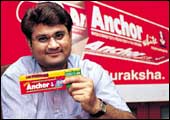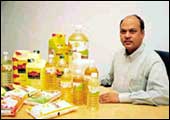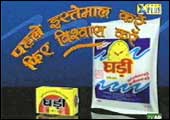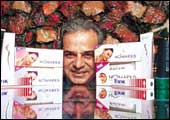 |
| M.S. Banga, Chairman, HLL: Facing an
uphill task |
There's
this dictum in the rulebook of the Anglo-Dutch foods and consumer
products giant, Unilever, that forbids managers anywhere in the
world from travelling on highways after 7 pm or once it gets dark,
whichever comes first. That's why last fortnight Manvinder Singh
Banga, the dapper Chairman of Unilever's Rs 10,668 crore Indian
operations, Hindustan Lever Ltd, was keeping an eagle eye on his
wristwatch during the bumpy drive in the backseat of a Mitsubishi
Lancer from Morena to Rajkot in southern Gujarat. The HLL chief's
mission: collect market feedback, and coax dealers to stock his
company's myriad products.
Banga did manage to stick to that 'don't-drive-after-dark'
deadline last fortnight, but when it comes to his company you have
to wonder. For the past two years, has India's premier, savvy and
street-smart fast-moving consumer goods (FMCG) marketer been cruising
in the dark on a road to nowhere? In this period, growth for HLL's
soaps, detergents, tea, personal products and packaged foods slowed
down-along with the market-and even dipped into negative territory.
From a scorching compounded annual growth of 26 per cent from 1993
to 1999, Lever has lost plenty of steam. Second-rate, single-digit
growth isn't something you'd expect from HLL. Certainly not pre-2000.
| WHAT'S GOING WRONG AT HLL? |
| The 90s' big launches
have bombed...
Product Fate
Aim Discontinued in 2001
(Rural toothpaste)
Impulse Discontinued in 2002
(Women's Deodorant)
Revel Discontinued in 2001
(Washing Machine detergent)
Calvin Klein * Discontinued in 2001
(Toiletries)
Surf Laundry Services Still in test market
Aviance Reworking market approach
(Premium cosmetics)
*Part of product line imported from Unilever
...Key brands are correcting course...
BRAND
NEW PLAN
Annapurna (Staples)
Chase only profitable sales
Kissan (ready-to-eat impulse foods)
Target kids with processed foods
Max (Kids brand)
Extend the kids ice cream brand to confectionery, stationery
Kwality-Walls (Ice Cream)
Make it a premium brand for metros
...And it's been tardy entering
new segments...
SEGMENT
LAUNCH
Confectionery (Max)
2001
Spl. Hair Care
2001
Niche Skincare
2002
Ayurvedic Products
2002
...Now, it is drawing up new rules
to play by.
CATEGORY: STRATEGY
Soaps & Detergents: Redefine market for brands;
aim for cost-effective product differentiation
Beverages: Chase out-of-home opportunities aggressively;
slash costs in price-sensitive, in-home products
Foods: Build a value-added processed foods portfolio
across Kissan and Annapurna
Ice Creams: Concentrate only on top metros, and drive
only value-added segments.
Personal Products: Launch variants, and price low
to get volumes back in toothpastes and shampoos
New Ventures: Leverage scale to grow new businesses
into Rs 300-500 crore big in next five years
|
In Rajkot, Banga tries to find answers to some
elusive questions-and the elusive growth. "Which is the best-selling
shampoo in your store?" he quizzes a dealer. "Is Vaseline
Crack Relief picking up?" flies another query. "And what
about Surf's Rs 2 pouch?" Then there's inevitable hardsell.
"Why don't you stock Kissan Squash, you know it is the best
squash in the country," he urges a gloating proprietor of the
brand-new, neatly-laid-out, self-help Shital Supermarket.
Such banter in the marketplace may help HLL
build (or should we say rebuild) bridges with shopkeepers across
the country. But there's another question that must be keeping the
HLL top brass awake at night, and the answer to which may not lie
in the market but in your home. "Just why are consumers not
buying enough from HLL?" "The biggest concern is that
the company is losing marketshare in a stagnant/declining market,"
says Nirav Sheth, Vice President (Research), SSKI Securities.
Indeed, even till 1995-96 HLL had limited competition
to contend with in most categories. Then came the likes of CavinKare
(with shampoos), VVF Ltd (soaps), Anchor Health (toothpastes) and
Paras Pharma (in skincare), who began chiselling away at Lever's
chunky market shares. What's also not helping the HLL cause is that
the other big boys-Colgate, Procter & Gamble, Godrej, and Marico-have
begun getting their act together and are formidable competitors
in crucial categories.
HLL's power-brand strategy announced in January
2001-conceived by Unilever-which called for focusing on a basket
of key brands (30 power brands and 10 regional levels) doesn't seem
to have helped prop up that topline, either, although it has had
a positive impact on profits. "The company was in serious danger
of losing even its earnings growth had it not been for the power
brands," points out Rajesh Kothari, FMCG analyst with Khandwala
Securities.
Tell Banga that the power brand strategy is
a failure-as some analysts suggest-and you'd have probably got his
goat. "Companies must pace themselves well. I am of the view
that our strategy of creating 'fuel for growth' is working,"
he maintains. But really, it would be uncharitable to heap all of
the blame for HLL's no-growth patch on the current chairman. Travel
back instead to the early and mid-nineties, when much of HLL's growth
was fuelled by acquisitions. To be sure, between 1993 and 1998,
the FMCG giant's organic growth was just 14 per cent on an annual
compounded basis. Acquisitions-of Tomco, Kwality Ice Cream, Dollops
Ice Cream (from Cadbury) and Lakme-and the mergers of all of Unilever's
India businesses into HLL (Brooke Bond, Pond's and more recently
International Best Foods) accounted for the remaining 12 per cent.
"These businesses needed a little more
time to be absorbed in HLL, and of that we had little, what with
the scorching pace of acquisitions scripted by the then chairman,"
says a former senior manager who was in the thick of the HLL merger
mania of the nineties. One of the costly legacies of the acquisitions
rush was multiple distribution channels leading into rural India,
one for soaps and detergents, another for personal products, and
yet another for beverages. Not just that, such a product-category-led
system meant that rural markets-which account for nearly 45 per
cent of HLL's profits-were just the tail of every sales territory
rather than its focused head, to be grudgingly serviced. It is only
recently that Banga has integrated the entire rural penetration
into one, with a separate and dedicated force-regional sales manager
downwards-for the rural areas.
 |
|
Dalip Sehgal, Head (New Ventures), HLL
HLL cannot rely too much on its new businesses,
even though some of its newer brands are making profits
|
Another of yesterday's mistakes could have been
reacting to price warriors like Nirma, Amul, Fena and CavinKare
by launching discount brands or extensions at lower-price points.
That worked up to a point. Until the bit players-Kanpur Detergents,
makers of Ghadi detergents, VVF, Ayur et al, started doing a "Nirma
on Nirma." Lever suddenly realised it couldn't play this bare-bone
cost game. "In hindsight, we should have been raising the hurdle
instead of getting into playing the game their way, which was on
just price," admits a candid Aart C. Weijburg, Director (Detergents),
HLL.
"To keep the growth engine chugging, even
at single digits, for a company of HLL's size, a good number of
product innovations and brand launches were needed regularly. But
there were very few," says Jigar Shah, Head of Research at
K.R. Choksey. The regional brands, in the meanwhile, took off. Geogi
E. Zachariah, Group Product manager of the Rs 100 crore Jo soap
brand from Mumbai-based VVF refuses to buy the logic that consumers
are gravitating towards lower-priced brands just because of recessionary
conditions. "What we are offering the consumer is a product
of much better quality at half the price," he volunteers. In
HLL's case, meantime, it's difficult to recollect a successful brand
launch in the past decade. Be it Aim toothpaste or Le Sancy soap
or washing machine detergent Revel, or women's deo Impulse (or the
distribution of Unilever's Calvin Klein in India), none of these
brands caught the consumer's fancy.
Then there's the dilemma in foods, with Annapurna.
HLL got it wrong to begin with by rapidly making inroads into staples
in 1995-perhaps too rapidly, given the low-margin, low-differentiation
nature of the business. In a bid to convert consumers from loose
to packaged atta, Lever spent heavily on advertising, with no attempt
to even start creating a value-added processed foods portfolio.
The growth in staples did not live up to the investment, and the
business is still bleeding though Banga hopes to make it profitable
soon. Gunender Kapur, Executive Director (Foods) says profitability
in atta is an issue in the North and the East, but "it is our
objective to build a profitable foods business."
 |
|
D. Ravindranath, ED (Beverages), HLL
Among the thing HLL plans to try out is
a huge out-of-home foray into tea with Lipton parlours
|
HLL's famed marketing firepower was not enough
to make its foray into ice creams a success, either. For five years,
Lever crossed swords with Gujarat Co-Operative Milk Marketing Federation
(GCMMF). Final result: Amul is King, a battered HLL retreats from
the mass market to focus on the top metros (which are more profitable),
and that too with only value-added products. "How could they
even think all this while of competing with us for the mass-market
with just one product (ice-cream) when our production, promotions
and distribution costs were spread across the entire dairy line,"
sniggers R.S. Sodhi, General Manager (Marketing), GCMMF.
If HLL is guilty of not earning enough returns
on huge investments in some categories, you can also accuse the
marketing behemoth of cold-shouldering sunrise opportunities. Like
direct selling, for instance, which has quietly become a Rs 1,600
crore business, a large part of it being personal products with
Amway, Oriflame and Avon ruling the roost. HLL, with Aviance, is
still knocking at the door.
So what's going to rescue HLL now? Don't rely
too much on the new businesses-confectionery, herbals, etailing,
etc-though Banga expects them to contribute between Rs 300 crore
and Rs 500 crore in five years. Dalip Sehgal, Head (New Ventures),
says the Max confectionery brand is already profitable. Creditable
indeed, but don't expect its Rs 50 crore revenues for the current
year to do much more than tickle the topline. "In the foreseeable
future new businesses can't be swing factor for HLL, although they
are as important as shampoo seeding way back in 1991-92," points
out Sandeep Bhatia, FMCG analyst with UBS Warburg.
 |
|
Gunender Kapur, ED (Foods), HLL
"Profitablity in atta is an issue in
the north and the east, but it is our objective to build a
profitable foods business"
|
So it is around HLL's existing businesses that
Banga claims that the growth swing will unfold, most likely in 2003's
second half. "Well, the market says a soap is a soap and that
emerging categories are mobile phones. What about intensity of consumption?,"
questions Banga. Already the company has put its key soap brands
in Lifebuoy, Lux and Liril through the re-launch paces, resulting
in at least the market share decline being arrested. "For us,
getting soaps and Wheel right was first, and in 2003 we will attack
top-end laundry wash in Surf and Rin," says Weijburg.
For the next 6-12 months HLL has lined up its
most ambitious foray into processed foods, that includes biscuits,
spreads, spices, and cooking aids. As S. Ravindranath, Executive
Director (Beverages) reveals, also on the anvil is a huge out-of-home
foray into tea with Lipton parlours. HLL will also push ready-to-eat
Annapurna chapati through the Modern bread-distribution system.
And there will be a renewed focus on low-unit-price packs, even
going down to infra-dig 50 paise sachets and a Rs 5 Pond's jar.
The scale of those plans sound intimidating,
but competitors these days don't fear the marketing juggernaut so
much-maybe not at all. As GCMMF's Sodhi quips: "Well, like
in the past, we'll let them create the market. Then we will take
away the consumer." For HLL and Banga, it's nearing 7 pm, and
getting dark...
WHAT SLOW-DOWN?
Slowdown, at least in the FMCG business,
seeems to be an HLL affliction. A clutch of homegrown marketers
is not just growing at a blistering pace, but taking away share
from their larger competitors such as HLL. So just how are they
doing it? BT looks inside eight of the newer challengers.
|
 |
|
Anchor's Atul Shah: Positioning made all the
difference
|
Anchor Health
The Vegan Smiles
Four years ago, when Atul Shah ventured into the FMCG industry,
he was flying in on a brand and a hope. If Shah is all teeth
today it's because his flagship Anchor toothpaste is a Rs
150-crore brand with a marketshare of 9.7 per cent-behind
Colgate-Palmolive and HLL. What explains the explosive growth?
One, the choice of market and positioning. Anchor focused
on predominantly vegetarian Gujarat and Rajasthan, and positioned
its toothpaste as a vegetarian product. Two, price. A 250-gm
pack of Colgate costs Rs 62, while Anchor's 200-gm pack costs
Rs 35. Says Shah: "We offer quality at a price that our
competitors can never match." He now plans to launch
soaps and detergents, and beauty products.
-Dipayan Baishya
 |
|
Parakh Foods' Prakash Parakh: Shift to packaged
oils helped
|
Parakh Foods
Oil Money
If you don't live in west India and any of the smaller towns
elsewhere, you probably haven't heard of Gemini. But HLL's
sure to have heard of it. Launched six years ago, Gemini today
is packed out of the largest single-location edible oil factory
in India. It claims to have a 12 per cent share of the Rs
4,000 crore edible market, and leads in the western region.
Prakash Parakh, the company's MD, expects the 25 per cent
rate of growth to continue for the next few years. Parakh
has benefitted tremendously from the consumer's shift from
loose edible oils to packaged oils. But the shift isn't complete.
A good 70 per cent of the market is still for loose oils.
Says Parakh: "We believe in reasonable pricing and increasing
the reach so as to grow faster."
-Shilpa Nayak
Jyothi Labs
The Bright One
This is the company that humbled Reckitt-Benckiser in the
fabric whitener business. Jyothi's Ujala apparently controls
75 per cent of the Rs 200-crore market. Says M. P. Ramachandran,
its ceo, who thought of Ujala in 1982 while working as an
accountant at a chemicals trading firm: "The secret of
our success is very systematic marketing on a large-scale
basis throughout the country." Last year, Jyothi launched
Maxo mosquito repellent, and more recently Exo, a washing
bar. Ramachandran's vision, however, is to be a comprehensive
FMCG company, a target he plans to achieve over the next few
years.
-Shilpa Nayak
 |
|
Ghadi detergent: Growing at biggies' expense
|
Kanpur Trading Company
The Next Nirma
KTC's murli Gyanchandani is another Munusamy. And he is widely
seen as the next Karsanbhai Patel of Nirma. Born as a home-delivered
brand, Ghadi Detergent, is said to be a Rs 450 crore business,
with a strong presence in North. People in the know attribute
Gyanchandani's success to clever pricing and attention to
quality. At Rs 17 a kilo, Ghadi takes Nirma head on. The second
brand Double Dog Detergent sells at Rs 50 per kg and targets
premium MNC brands.
-Seema Shukla
 |
|
Ozone's S.C. Sehgal: Ayurveda proved a big hit
|
Ozone Ayurvedics
Full Marks
S.C. Sehgal, a seven-year veteran of Glaxo, had been running
a pharma company for nine years before he one day decided
to take a trip to New York, London and Paris to search for
a new direction for his company. He needn't have bothered,
for the answer-as he later realised-was staring him in the
face from shop shelves. A growing number of ayurvedic products.
That was in 1991. Two years of research later, Sehgal came
up with No Marks, which till 1999 was unbranded. Now, his
ayurvedic business is set to overtake his Rs 40-crore pharma
business. Some savvy advertising-such as advertising on Aaj
Tak, the biggest Hindi news channel-has created a hi-profile
for the brand, which currently rakes in Rs 4 crore in sales
every month. Sehgal already exports to the Middle East and
has clearances for Canada. His dream, however, is to see No
Marks in the stores he visited in London, New York, and Paris
in 1991.
-Seema Shukla
 |
|
Kaleeswari: An impressive Southern story
|
Kaleeswari Refinery
Tear, Sweat, and Oil
G. Munusamy hates the media. That's because he'd rather work
than talk about it. Good idea. In fact, so good that it has-in
just 30 years-helped him turn from an oil trader to a mini
(edible) oil tycoon. His Kaleeswari Refinery, set up in 1995,
has gone from 25 tonnes per day (TPD) to 285 TPD today, with
an expected turnover of Rs 340 crore this fiscal end. "Our
motive was to penetrate the market with attractive pricing
and volumes," says General Manager T. S. Sethuramachandran.
To cut costs, its Gold Winner brand does not use middlemen
in Chennai, but sells directly to stores. But elsewhere in
Tamil Nadu, it works through 10 dealers. Munusamy's dream:
to make Gold Winner an international brand.
-Nitya Varadarajan
 |
|
RDM's D.S. Narang: Herbal products proved a
goldmine
|
RDM Traders
Slow And Steady
A tiff with his boss changed D.S. Narang's life forever.
That was the day when he quit being an employee and turned
entrepreneur, manufacturing herbal products at his home in
Delhi's Patel Nagar. Today, with six plants, 1,500 distributors,
and 22 C&F agents, Narang's 10-year-old Ayur herbal brand
fetches Rs 100 crore a year. His USP: "I get amala for
Rs 10-20 per kg and sell my shampoo for Rs 80, while others
sell theirs at Rs 200. How much can you charge for a name?"
asks Narang. RDM recently entered south in a bid to enhance
its national presence. But the man says he is no hurry. He
wants to build brand slowly and steadily.
-Seema Shukla
 |
|
Kunvar Ajay Ind's S. Agarwal: Mahatma's blessings?
|
Kunvar Ajay Ind.
A Movement
What kind of a commodity product rakes in Rs 50 crore in
five months? If it's Dandi Namak-at least that's what Suresh
Agarwal of Kunvar Ajay Industries would have you believe.
Faced with stagnation in the saree business, Agarwal ventured
into the FMCG business with an impeccable logic. If HLL could
outsource 90 per cent of its products and still become an
FMCG behemoth, why couldn't t the others? Agarwal's Kunvar
Ajay Foods isn't quite there yet, but he's working on it.
He claims his Dandi brand is Rs 125-crore big, despite being
priced at par with Tata salt at Rs 7. If price isn't Dandi's
plank, what is? Surprise, it's image. It claims to be a triple-refined,
free-flowing, pure salt-a message reinforced rather bluntly
in its advertising campaigns. In May this year, Kunvar Ajay
launched Friendly Wash, and-as per his claims-has already
clocked Rs 35 crore in sales. Next on the cards: Atta and
shampoo brands.
-Dipayan Baishya
|
|

